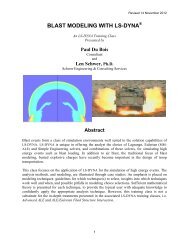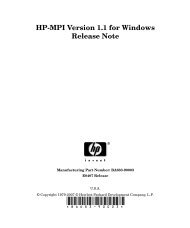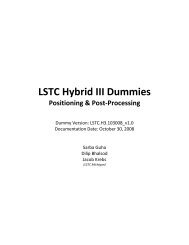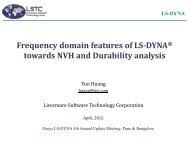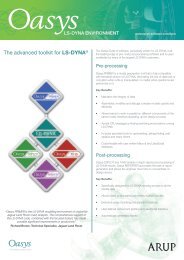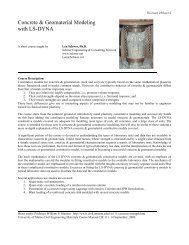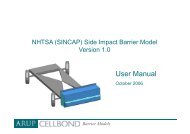Oasys LS-DYNA Environment 8.1 VOLUME 3 ... - Oasys Software
Oasys LS-DYNA Environment 8.1 VOLUME 3 ... - Oasys Software
Oasys LS-DYNA Environment 8.1 VOLUME 3 ... - Oasys Software
You also want an ePaper? Increase the reach of your titles
YUMPU automatically turns print PDFs into web optimized ePapers that Google loves.
<strong>Oasys</strong> <strong>LS</strong>-<strong>DYNA</strong> <strong>Environment</strong>: User Guide (Version <strong>8.1</strong>)<br />
12.0 TIMESTEP CONTROL<br />
The timestep in <strong>LS</strong>-<strong>DYNA</strong> is generally limited by stability. Usually, the timestep falls during<br />
an analysis as elements become deformed. It is also possible for the timestep to rise. <strong>LS</strong>-<strong>DYNA</strong><br />
automatically calculates the largest timestep which can be used without triggering numerical<br />
instability; it is not possible to force the code to use a timestep larger than this. It is, however,<br />
possible to force the code to use a timestep smaller than the calculated value, either by defining<br />
a multiplying factor less than the default value of 0.9 (SCFT on *CONTROL_TIMESTEP), or<br />
by specifying a timestep-vs-time loadcurve (LCTM on *CONTROL_TIMESTEP).<br />
Instability (shown by rapidly rising energy and a "floating overflow" error) will occur if the<br />
period of any mode of deformation in the model is less than π times the timestep. Thus the<br />
timestep must divide the period of the highest mode by at least π. Generally the highest mode<br />
is a single element mode, i.e. oscillation of a single brick, shell, beam or spring element.<br />
<strong>LS</strong>-<strong>DYNA</strong> checks all elements when calculating the required timestep. The timestep can be<br />
estimated roughly using the formula<br />
ìt = 0.9 L/c (solid, shell, beam)<br />
where l is the smallest element dimension and c the speed of sound in the material. Shell<br />
thickness and beam section dimensions are ignored when finding l. Rigid elements are not<br />
included.<br />
More accurate estimates can be obtained using l and c instead of l and c as follows:<br />
L = Volume/Area of largest surface (solid elements)<br />
L = as per ISDO on *CONTROL_TIMESTEP.<br />
c = (E/ρ)<br />
E = K + 4G/3 = E(1-ν)/[(1+ν)(1-2ν)]<br />
It is possible for flexure modes of Belytschko-Schwer beams to control the timestep especially<br />
if they are short in comparison to their section dimensions. In this case,<br />
t =014l 2 (A(12r + 1)/I(3r + 1))<br />
c'<br />
Where A = cross-sectional area<br />
I = maximum of I ss, I tt, J<br />
r = I/(Al 2 )<br />
Page 12.1






